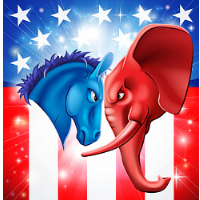Political Partisanship of Americans at Highest Level in a Quarter-Century
 (graphic: ChrisGorgio, Getty Images)
(graphic: ChrisGorgio, Getty Images)
By Niraj Chokshi, New York Times
Fistfights at campaign rallies. A congressional sit-in. Angry political trolling on the internet. It’s not your imagination: America’s partisan divide is deeper today than at any point in nearly a quarter-century, according to a new study.
For the first time since at least 1992, the majority of Democrats and Republicans say they view the opposing party “very unfavorably,” the Pew Research Center found in a report published Wednesday. At the same time, around half the members of either party said their opponents stirred feelings of fear and anger in them.
“It’s really this intensity of negativity that’s increased,” said Carroll Doherty, director of political research for Pew and one of the report’s authors.
While the Pew research only goes back to 1992, the results conform with decades of growing partisan negativity in data from the American National Elections Study, a collaboration of Stanford University and the University of Michigan, Doherty said.
“You see that the same trend’s apparent going all the way back to the 1960s,” he said. “It’s really the rise of very negative views, that’s what’s most apparent if you look at our trend.”
Today, according to Pew, 91 percent of Republicans view the Democratic Party unfavorably, with 58 percent holding “very unfavorable” attitudes toward it. Among Democrats, 86 percent view the Republican Party unfavorably, while 55 percent hold it in a very unfavorable light.
The Republican Party strikes fear in the hearts of 55 percent of Democrats surveyed, Pew found. Among Republicans, 49 percent felt the same way about the Democratic Party.
At the same time, 47 percent of Democrats said the Republicans made them angry, while 46 percent of Republicans said the Democratic Party made them feel angry.
The results are based on a survey of nearly 4,400 adults conducted mostly in March and April.
In many ways, negativity toward the other party is stronger than positivity toward a person’s own, the Pew authors note.
While Democrats and Republicans generally agree with their own party most of the time, only 16 percent of Republicans and 20 percent of Democrats reported “almost always” agreeing with their own side’s policies. Yet, 44 percent of each party’s membership said they “almost never” agree with their opposition.
That rising partisanship has been matched by an increase in the number of political independents, who still tend to lean toward one party or the other, Doherty said. But even the direction in which those independents gravitate is defined more by opposition than support.
“It’s not because they have any great support for the policies of that party” toward which they lean, Doherty said. “Again, it’s negative views of the policies of the opposing party.”
Partisans also tend to have dim views of individuals. A large majority of Democrats find their political opponents especially rigid, with 70 percent saying Republicans are more close-minded than other Americans. Democrats said Republicans stood out in other ways, too: 42 percent found them more dishonest than other Americans; 35 percent said members of the other party were more immoral than the rest of the nation.
While a smaller share of Republicans found Democrats especially rigid, larger proportions — between 45 and 47 percent for each category — said Democrats stood out for their immorality, laziness or dishonesty.
Just over half of Republicans surveyed, 52 percent, said Democrats were more close-minded than the rest of the populace.
Roughly 1 in 3 members of each party said they considered their political counterparts to be less intelligent than other Americans.
Partisanship aside, the majority of members in both parties felt they would have little trouble maintaining civility with their political counterparts. Less than a third of Republicans and Democrats said they would have difficulty getting along with a new member of their community who belonged to the opposition.
But that doesn’t mean it would be easy. Exactly half of Republicans and 46 percent of Democrats said they find talking politics with a member of the opposing party to be “stressful and frustrating.”
To Learn More:
Partisanship and Political Animosity in 2016 (Pew Research Center)
As Republicans Drift Right, Gap between House and Senate is Greatest Since at least World War I (by Noel Brinkerhoff, AllGov)
In California, Democrats and Republicans are Farthest apart; In Louisiana, there is Barely a Difference (by Ken Broder, AllGov)
Republicans Drifting more and more to the Right While Democrats Remain the Same (by Noel Brinkerhoff and David Wallechinsky, AllGov)
Animosity between Democrats and Republicans now Greater than between Whites and Blacks (by Noel Brinkerhoff and David Wallechinsky, AllGov)
- Top Stories
- Unusual News
- Where is the Money Going?
- Controversies
- U.S. and the World
- Appointments and Resignations
- Latest News
- Trump to Stop Deportations If…
- Trump Denounces World Series
- What If China Invaded the United States?
- Donald Trump Has a Mental Health Problem and It Has a Name
- Trump Goes on Renaming Frenzy






Comments